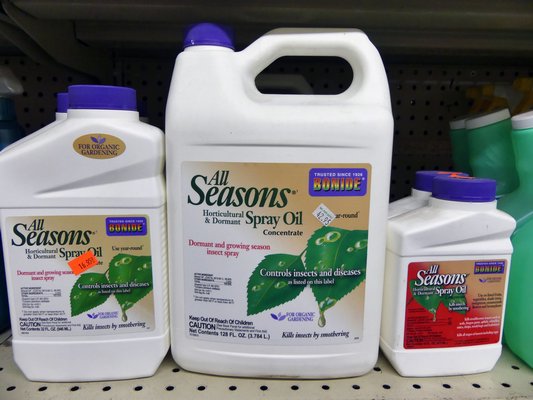

Some of your trees, shrubs and roses may need to be oiled. Yes, you can go out into a wooded area or maybe into your yard on a windy day and hear the creak and squeak of the trees but this isn’t an oil that has anything to do with lubrication; instead, this oil stops things that go chomp, chew and slurp and when properly used and applied this oil can reduce insect problems on your ornamentals dramatically with little to no environmental impact.
Years ago oil sprays were all called “dormant” oil spray. While some of their use is still during the period when plants are dormant, new production techniques, oil formulations and research have resulted in oils that can be used year-round on vegetables, fruits and ornamentals. But the heavier true dormant oil is the one that should be going on your fruit trees and others in the coming weeks. The primary use of dormant oil sprays is primarily to kill the eggs and over wintering stages of a wide range of insects such as aphids, mites, plant bugs, scales and certain moths.
The true dormant oils may not be strictly organic so if you have an organic property or orchard make sure that the oil you or your spray technician is using has an ORMI label on it. Also, keep in mind that while dormant oils and all-season oils are extremely safe they can damage plants if they are used on the wrong plant or under the wrong conditions. Realize also that all the oils are indiscriminate. That is, they have the potential to kill both beneficial and harmful insects. At the same time, few beneficial insects are around and about when the true dormant oils are being applied.
Oils act like contact insecticides whose mode of action is physical rather than chemical. For this reason, the spray is effective only when the insect or egg is present as there is no residual effect. The action that kills the insect is that of smothering or suffocation as the oil coats the body or egg. In a way, this is the lesser of all evils as an application of oil to the right plant at the right time may sharply reduce or eliminate the need for using other much more toxic insecticides later in the season.
As mentioned, these oils are very safe to use as there is very little risk of dermal (through the skin) hazards to mammals as well as birds and reptiles. In fact, a more refined version of these oils is plant based with many being derived from canola oil.
Another good thing about these products is that most homeowners can apply them with a small gasoline, electric power sprayer, a back-pack type sprayer or with a trombone sprayer. For larger trees and shrubs, however, having a registered pesticide applicator do the work is almost a necessity and the payback is almost immediate.
To know which type of oil to buy and use you must understand the label. In true dormant oils, a number following “unsulfonated residue” gives the degree of purity in percent. A U.R. rating of less than 92 percent is unsatisfactory. Gravity (specific gravity) is a measure of viscosity and density. A number of 40 degrees or greater indicates a highly paraffinic oil, important both in insecticidal effectiveness and plant safety. An API range between 30 and 40 would be suitable for dormant treatments. Distillation range gives information about the expected speed of evaporation, or persistence, when sprayed on trees. If the oil evaporates too fast it loses its insecticidal efficiency, but if it does not evaporate fast enough plant injury may occur. The pour point is listed to ensure having the oil in a liquid state during early season use and any superior oil that remains liquid at 20 degrees Fahrenheit should be safe for all your early uses. All this information is easily found on the bottle. The lighter all season oils such as SunSpray are very light and not well suited to late winter dormant application.
The label will also tell you what plants not to spray with oil and with newer oils these are very few, especially on deciduous trees and shrubs. The same holds true of conifers, however, there will be a cosmetic effect if oil is sprayed on glaucous conifers such as Colorado blue spruce—so read the entire label. Oil sprayed on such trees can result in the loss of the bluish color for as long as three years. The label will also contain some temperature cautions. Low temperatures shouldn’t have any significance since it isn’t practical to spray trees when the temperature is below freezing, so don’t. If spraying is done at or near freezing or if it freezes within several hours of spraying the evaporation may be hastened or the oil may accumulate on certain portions of the plant causing overdose damage—but it’s unlikely. It seems the best application situation is when buds are not yet open, when the daytime temperature is at or below 50 degrees and when the night temperature isn’t expected to go below freezing and remain that way for 24 hours. Don’t let your arborist spray dormant oils if these criteria aren’t met and don’t assume they pay careful attention to this.
It’s much more likely that damage will be done from high temperatures as this combined with the oil may interfere with plant respiration. Climatic conditions that cause an increase in respiration or demand for water in a tree (such as heat or dry winds) may create the conditions for leaf damage if replacement moisture is not available in the root zone. These symptoms are usually described as scorch, and oil on the leaf will aggravate it. A note of caution: Consider what’s under the trees and shrubs that you are spraying oil on. Pansies and violas are very susceptible to oil damage as are hairy grey foliage plants such as Artemisias (wormwoods) and a few herbs.
Other horticultural oils are referred to as ultra fine (or superior) and they have broadened the scope of plant material that can be sprayed as well as the time of the year that they can be used. Indoors, you can control aphids, mealybugs, scale, mites and whitefly on a wide range of plants including many ferns, jades, philodendrons, geraniums and begonias. In greenhouse vegetable production, it is used on peppers, tomatoes and cucumbers and many of us rely on oils in the vegetable garden, but again, read the label. For those of us with more than a passing concern about our environment an insecticide that combines canola oil and pyrethrin gives us the ability to kill a broad range of harmful insects on contact while having a minimal effect on beneficial insects and our garden ecology. With two modes of action, one being the smothering effect of the oil and the second the killing effect of the pyrethrin, this insecticide does not have the one quality that has given other insecticides very, very bad names: persistence. The canola-pyrethrin combo works within minutes then rapidly degrades. It still needs to be used with caution, as all insecticides should, and it’s extremely toxic to fish, but when used properly this type of insecticide can be a fruit, vegetable and ornamental gardener’s best friend.
As always, read the label, follow it carefully and … keep growing.
 More Posts from Andrew Messinger
More Posts from Andrew Messinger